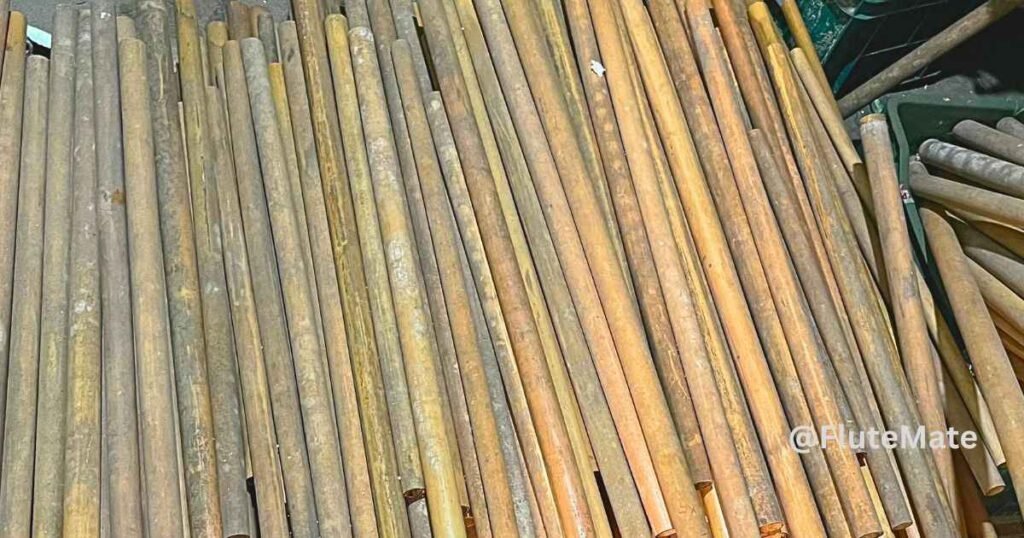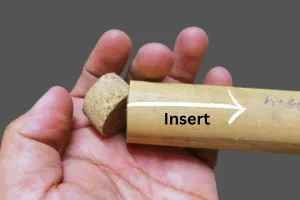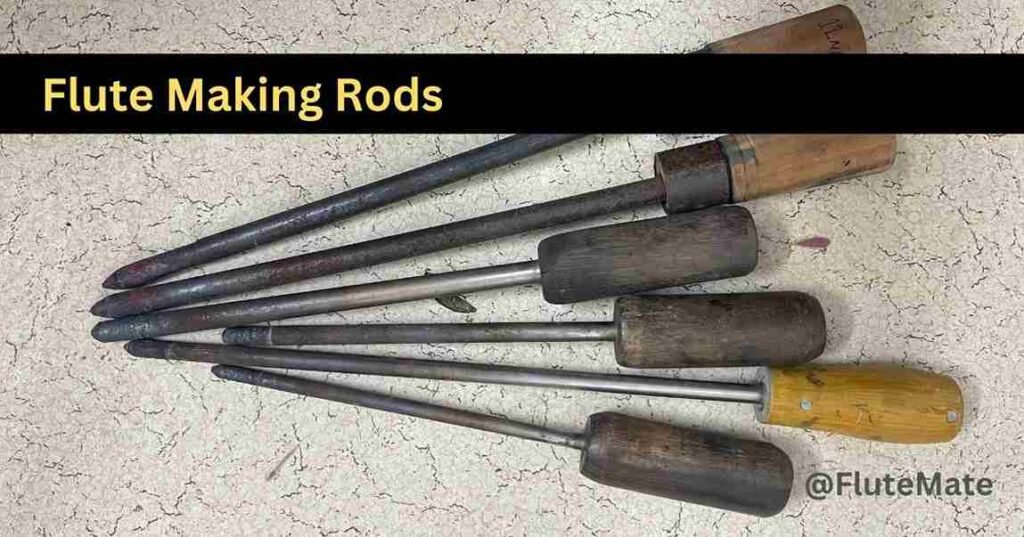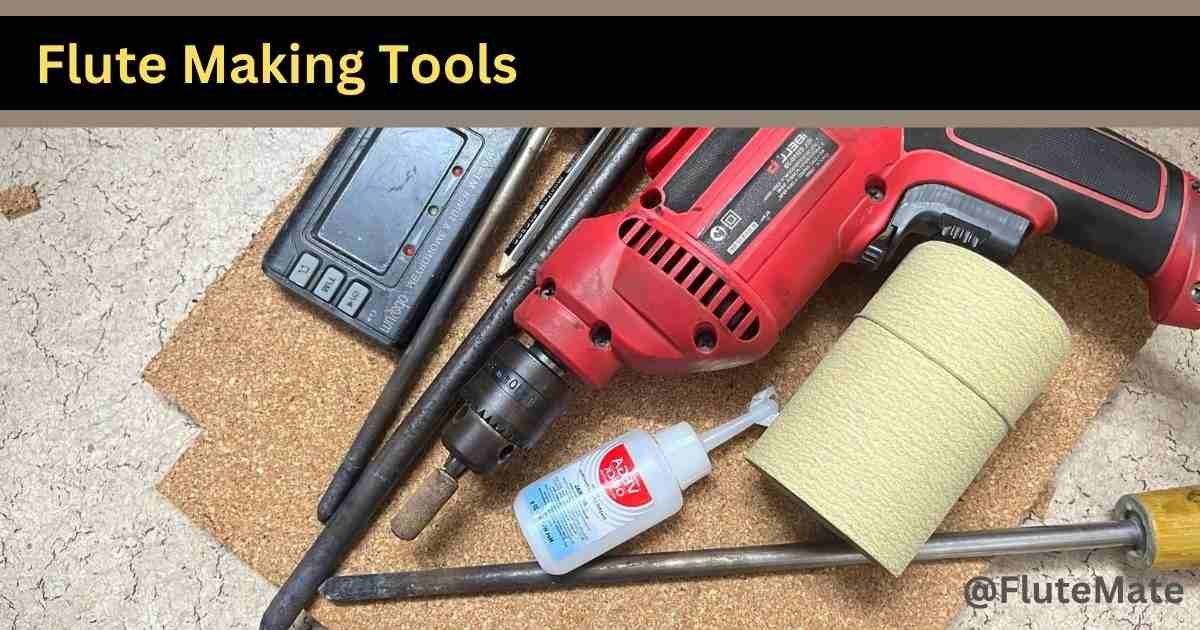Introduction – Essential Flute making Tools
Flute making doesn’t require a hi-fi setup. With the help of simple flute making tools, you can start making your own flutes right away.
In addition to prerequisite resources like FluteMate (the smart flute calculator) and the necessary flute measurements chart, you’ll need a few tools to make your own flutes.
In this article, we’ll list the 11 most essential flute making tools. Some of these tools can be easily found , while others you need to purchase. And if you want to purchase these flute making tools, we have given links from which you can purchase easily from amazon.in.
Here’s a complete list of 11 essential flute making tools, along with sources from where you can easily purchase them.
1. Bamboo or Pipe
Bamboo or a piece of pipe comes first in the list of flute making tools or the raw material. We’ve already discussed the things to consider when choosing bamboo for flute making in a previous section. In the following paragraphs, we’ll guide you on how to obtain bamboos or pipes which are the foremost essential flute making tools.

(A) Bamboos
Rather than selecting the right bamboo, obtaining good quality bamboos for making flutes is a challenging task. It is because the right species of bamboo is not readily available around us.
Out of the 11 essential flute making tools, you have to obtain the bamboos first. If you want to obtain bamboo for making flutes, it is important to find the right bamboo dealer. Majority of bamboo dealers are in Pillibhit, Uttar Pradesh, India, or in Assam, where the specific species of bamboo known as ‘dolu‘ grows.
How to Buy Bamboos for Flute Making?
You can find out contact numbers of these bamboo dealers in YouTube or can find in google.
If you are still unable to find a bamboo supplier, you can leave a comment with your email address in the comment box below, we will provide you with the contact details of some bamboo dealers in Assam.
(B) Pipe or a Tube
Owing to its ideal natural characteristics, it is highly recommended to use a bamboo instead of a chemical made or metallic pipe to make a flute. However, it is ideal to include pipe to the list of essential flute making tools as an alternative to bamboos.
Prior to making flute using a pipe, there are certain advantages and disadvantages that you should take into considerations. These include:
Pros
- Pipe, as a basic tool for making flutes, has the advantage that it is usually machine-made. A pipe ensures that its attributes such as straightness, roundness, and wall thickness are uniform and consistent.
- Many flutes of same scale can be made using the same measurement.
- Accurate tuning can be obtained on flute made of pipe
- A pipe is strong and hence the flute does not brake easily
- No adverse affect of temperature
- No extra maintenance required
Cons
- One disadvantage of using a pipe to make a flute is that it can be difficult to find pipes in all sizes, which can make it impossible to make flutes of all scales, long or short, using pipes.
- Using of PVC or CPVC pipe pose health hazards due to the chemical content on them
- When using machine-made pipes, it can be impossible to achieve the same resonant sound or Javari as that of a bamboo flute.
- If the pipe used for making a flute is made of metal or any other hard material, it can be difficult to drill and shape it appropriately.
Where to get Pipes from ?
If you are looking to make a flute using a pipe, you can visit a nearby hardware store and purchase PVC or CPVC pipes, which can be suitable for this purpose. Additionally, you can also use acrylic pipes to make beautiful flutes.
2. Stopper Cork
Cork come second in the list of flute making tools. The cork in a bansuri is an important component that plays a crucial role in making the instrument work properly. When a musician blows air into the bansuri, the air travels through the mouth hole and enters the body of the flute.

Placed a few millimeters away from the blowing hole of the Bansuri, the cork creates a seal and prevents the air from escaping out of the top end of the flute. This ensures that there is a continuous column of air maintained throughout the length of the flute, which is necessary to create all the different sounds.
You can make a good stopper cork out of a rubber sheet or a rubber cork sheet.
Click on the image below to buy cork sheets from amazon.in.

3. Hacksaw or Electric Saw Machine
To make a bamboo flute, you will need to cut the bamboo into various sizes according to the measurements you have determined. To do this, you can use a hacksaw or an electric marble cutter.
If you don’t already have these tools, you can purchase them online from Amazon.in. There are likely many options available, so be sure to choose a tool that is suitable for your specific needs.


4. Sharp Multipurpose Knife
Another thing in the list of useful flute making tools is a sharp knife .You will need a sharp knife to cut the cork in the right size. A sharp knife is also helpful in making holes on a PVC pipe where using of metallic rods is not recommended for drilling holes.
Click on the image below to buy a sharp multipurpose knife from amazon.in.

5. Pencil or a Marker
One of the most essential flute making tools is a pencil or a marker. You will need a pencil or a marker to mark holes positions on a bamboo or tube.
Is it necessary to specify where to obtain a pencil or marker from?
6. Measuring Tools (ruler, Vernier caliper)
Whether for measuring the dimensions of bamboo or marking hole positions on a bamboo, you always need a long ruler or a measurement tape. The list of flute making tools is incomplete without mentioning these measuring tools.
It is recommended to use a Vernier caliper to measure the diameter of a bamboo or pipe and various holes in the flute.
You can buy these flute making tools from amazon.in. To buy click on the images below.


7. Drilling Rods or an Electric Drilling Machine
Metallic rods of various diameters or an electrical drill are very important flute making tools. Please note that longer flutes have bigger holes and smaller flutes have smaller holes. Hence, it is necessary to have rods of various diameters.
If you want to use electric drills to make holes, you will need appropriate drill bits.

If you want to make flutes on a regular basis, you should include rods of 6 mm, 8mm, 9mm, 10 mm, 11 mm and 12mm in your flute making tolls list. Also note that these rods should have pointed tips as shown in the image above.
Of late, many flute makers have started using power drill machines to drill holes as using of rods is a traditional way. You can get electric drills along with appropriate drill bits in www.amazon.in.
Click on the images below to buy from amazon.in


8. High Pressure LPG Gas Torch
Next in the list of essential flute making tools comes a high pressure LPG gas torch
If you prefer using metallic rods to make holes on a flute, you will invariably need an LPG gas stove or a high pressure gas torch to heat these metallic rods.
The LPG gas stove in your kitchen produces a low intensity flame, hence it takes a lot of time for the rods to get heated and turn red.
It is recommended to use high pressure gas torch if you want to make flutes on professional basis. Click on the image below to buy the high pressure LPG gas torch from amazon.in.

9. Tanpura or a Chromatic Tuner
Tanpura
The list of flute making tools does not complete without mentioning Tanpura. Bansuri or the bamboo flute is an Indian Classical Musical instrument. Therefore it has to be Shruti tuned which is the basis of Indian Classical Music. Hence, Tanpura is the only instrument you can use to tune a bansuri.
Since tanpura is one of the most essential flute making tools, you have to have a tanpura with you. For this , you can either rely on an electronic tanpura or an tanpura app on your mobile phone.
We have listed a few tanpura, both electronic and mobile apps below. You can use any of these to achieve your goal of tuning a bansuri.
Electronic Tanpura






 Mobile Application Tanpura
Mobile Application Tanpura
- Apple iTablaPro – For Apple device only (paid)
- Tanpura Droid – Free application for android device
- iShala – Paid application for android device
Chromatic Tuner
Many of you might not understand a tanpura, it takes time to develop sense to understand tanpura for all of us. For time being, you can include a chromatic tuner in the list of flute making tools which are easily available in the online market like amazon.in.
Two chromatic tuners are listed below, you can buy any one of them.
In case you want to use a mobile application, below are the options for you.
10. Sandpaper
One of the flute making tools your will need is sandpaper of various grits ranging from 150 grit to 3000 grit.
150 or 180 grit sandpaper is used for tuning the flute, 320 for fine tuning and rest will be required for getting the right glossy finish on the surface of the bamboo flute.
You can purchase sandpapers of various grits from www.amazon.in by clicking on the images below

11. Nylon Threads
Once you are done with making the flute, you will need nylon threads of various colors as you like to bind on the flute. Although, thread is not very essential as other flute making tools, but important to bind or decorate the flute which can save the bamboo flute from damage.
In addition, putting of threads on a flute has benefits like enhancement of external look and branding.
Below is an image of nylon thread for your reference, you can use nylon thread of TKT 40 for binding the flutes.

12. Adhesive or Glue
Adhesive or glue is also one of the essential tools in flute making. It is commonly used to fix the stopper cork at a fixed position on the flute. This helps to ensure that the stopper cork remains in the right place, which is important for maintaining balanced octaves. Without the use of adhesive, the stopper cork may slip off or move out of place, causing the flute to become out of tune and difficult to play.
During the flute-making process, bamboo can sometimes crack or sustain visible scratches. To repair these damaged parts, adhesive is needed.
Additionally, glue is required to secure the threads once they are tied on the flute, ensuring that they do not come loose or unravel.
Conclusion
In conclusion, you will need a variety of flute making tools and materials to achieve the desired sound quality and craftsmanship. From cutting and shaping tools to adhesives and sandpaper, each tool has a specific purpose in the flute making process. Proper use of these tools is crucial for creating a high-quality, well-crafted flute that will produce a beautiful and consistent sound.
With the right tools and techniques, anyone can learn to make their own flute and enjoy the process of crafting a unique and personalized instrument.
If you have any queries regarding flute making tools or where to obtain these tools from, please feel free to leave a comment in the box below. We would be happy to assist you in any way we can.
Related Posts:
FluteMate: 1 Secret Formula for Making Best Professional Flutes
How to use FluteMate? 100% accurate flute making formula!
How to choose bamboo for flute making : 3 Key Factors
Flute Measurement Chart & FluteMate – Make your dream flute easily
FAQs
Which bamboo is used to make flute?
Dolu and Muli bamboo which are primarily found in Assam, a state in Northeast India are also used to make flutes . These types of bamboo are known for their thin wall , good length between the internodes and lightweight characteristics, which make them suitable for creating bansuri flutes.
What is the best material for flute?
Bamboo is the ideal material for making the Bansuri flute, which is a traditional Indian bamboo flute. This is because bamboo possesses natural resonant properties and is highly durable. The lightweight and flexible nature of bamboo, along with its hollow core, makes it perfect for creating a range of pitches and tones. Therefore, Bansuri flutes made from bamboo are known to have excellent sound quality and playability.
Which flute is better bamboo or PVC?
In general, a flute made from bamboo is considered better than one made from PVC (polyvinyl chloride) because bamboo has natural resonant properties that result in a warmer and richer tone. Bamboo flutes are also lightweight, flexible but prone to cracking and breaking.
Additionally, bamboo is a sustainable and renewable resource, while PVC is a type of plastic that is not environmentally friendly. Therefore, if you are looking for a high-quality flute with a beautiful sound, a bamboo flute is a better option than a PVC flute.


Very well explained,thank you so much.
Very well explained,thank you so much,I appreciate it.
Nicely explained,thank you so much,I appreciate it.
Very nice and very professional.
Tomorrow I’ll try with your hepfull skills.
Keep on your good work!
Thank’s,
Thank you! your informations are very educational, nice and professionally concluded.
Wish you all the best
Regards
Ali
Where can i get different size of iron bars to make a flute ?
There is some flute maker called SP Chauhan (Accurate Flutes – 7015958550). Please contact him for iron rods.
Thanks